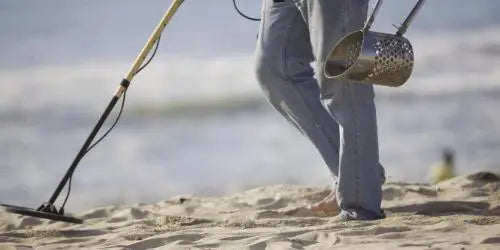
A GUIDE TO METAL DETECTING
Written by Lew Amicone
WHAT IS METAL DETECTING:
Metal detecting is a fun and educational hobby that has recently become quite popular, especially in the United States and England. A Metal detectorist typically use a piece of equipment known as a metal detector to help locate objects buried in the ground. Metal detectors use electromagnetic principles to pinpoint buried metal objects. They send a magnetic current through the earth and when the current hits a metal object, an electric current is generated, thus setting off the equipment’s sensors. While hobbyists make up the largest sector of metal detectorists, others also use it for other purposes such as criminal investigations, archeology, or military research. Coins are most commonly found through hobbyist sweeps of an area. Other items can include buttons, commercial tokens, military pins and badges, bullets, toys, and tools. In the United States, metal detectorists often report findings that date back to the 1700s and 1800s, and some even earlier. In various parts of Europe, skilled detectorists have also found objects that go back to Ancient Roman and Celtic times.
- Metal Detector – History of Metal Detector
- Metal Detecting History
- History of Metal Detecting & Archaeology in the United States
- Archaeology and Metal Detecting
- Archeology and Metal Detecting
- Metal Detection Technology
- History of the Metal Detector
- Metal detecting – only true stories about the hobby
HOW TO GET STARTED METAL DETECTING:
- Metal Detecting-How to Get Started
- Information on Metal Detecting and Treasure Hunting
- The Ultimate Beginner’s Guide to Metal Detecting
- Get Started In Detecting
- Getting Started in Metal Detecting
- 25 Metal Detecting Tips for Beginners
- Metal detecting, like most hobbies, is made easier when you have the right tools. Here are common tools and accessories metal detecorists use:
- metal detector (with extra batteries!)
- carry bags and backpacks for supplies and finds
- digging tools
- gold pans
- headphones
- pinpointers
- scoops
- search coils
- weather appropriate apparel and sunblock
Looking for metal detecting gear?: Treasure Classifieds – buy, sell and trade used treasure hunting gear
WHERE TO METAL DETECT:
Sometimes taking the time to do some research on where to start detecting can have a big pay off! Checking out old maps and other historical records of your town and the lay of the land can give you great ideas of where to start hunting!
Your local library should have plenty of historical records, newspapers, photographs and maps to look through. Make sure to ask for local history books! Inquiring about your local historical societies may prove to be beneficial as well! Speaking to older members of your community could even be
The website Historic Aerials is one of the biggest databases for historical aerial photographs in the United States!
Here are some other good places online to view historical maps:
Old Maps
- David Rumsey Map Collection
- Free USGS Topo Maps for the Entire United States
- Library of Congress: Collections with Maps
- Zoom Earth
Metal Detecting Clubs and Organizations:
Metal Detecting Tips, Tools and Resources:
- Best Metal Detectors For Finding Relics
- Best Metal Detectors for Finding Coins
- Tools for Metal Detecting
- Responsible Metal Detecting
- What are the Best Metal Detector Pinpointers?
- The Ultimate Guide to Metal Detecting
- Premier Metal Detecting Forum – Metal Detecting Forum
- Metal Detecting in the USA
- Cape Cod Metal Detectors
- Find’s Treasure Forums
- American Digger Magazine
- Friendly Metal Detecting Forum
- The Maryland Free-State Treasure Club
- Chicago Ron – Metal Detecting Website
- My Treasure Spot Forum
- Reddit: metal detecting – treasure hunting
- JANNER53’s METAL DETECTING BLOG
- Metal Detecting with Dirtscanner
- History Hunts
- TreasureNet.com — Metal Detecting Forum
- Stout Standards
Metal Detecting Manufacturers
- Fisher Research Laboratory – manufacturer of metal detectors
- Garrett Metal Detectors
- JW Fishers - Metal Detectors and Sonar
- Minelab Metal Detectors

Leave a comment